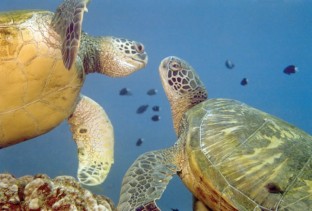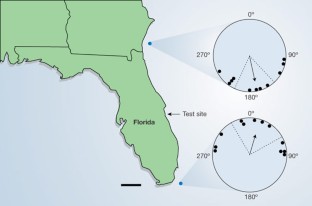Geomagnetic map used in sea-turtle navigation (original) (raw)
- Brief Communication
- Published: 29 April 2004
Animal behaviour
Nature volume 428, pages 909–910 (2004)Cite this article
- 6120 Accesses
- 36 Altmetric
- Metrics details
These migratory animals have their own equivalent of a global positioning system.
Abstract
Migratory animals capable of navigating to a specific destination, and of compensating for an artificial displacement into unfamiliar territory, are thought to have a compass for maintaining their direction of travel and a map sense that enables them to know their location relative to their destination1. Compasses are based on environmental cues such as the stars, the Sun, skylight polarization and magnetism2, but little is known about the sensory mechanism responsible for the map sense3,4. Here we show that the green sea-turtle (Chelonia mydas) has a map that is at least partly based on geomagnetic cues.
This is a preview of subscription content, access via your institution
Access options
Subscribe to this journal
Receive 51 print issues and online access
$199.00 per year
only $3.90 per issue
Buy this article
- Purchase on SpringerLink
- Instant access to full article PDF
Prices may be subject to local taxes which are calculated during checkout
Additional access options:
Figure 1

U. KEUPER-BENNETT
Figure 2: Orientation of juvenile green turtles (straight carapace lengths, 29–47 cm) tested in magnetic fields replicating those at the sites marked by blue dots.

Similar content being viewed by others
References
- Able, K. P. J. Avian Biol. 32, 174–183 (2000).
Article Google Scholar - Gould, J. L. Curr. Biol. 8, R731–R738 (1998).
Article CAS Google Scholar - Wiltschko, R. & Wiltschko, W. Anim. Behav. 65, 257–272 (2003).
Article Google Scholar - Avens, L. & Lohmann, K. J. J. Exp. Biol. (in the press).
- Lohmann, K. J. & Lohmann, C. M. F. in Loggerhead Sea Turtles (eds Bolten, A. B. & Witherington, B. E.) 44–62 (Smithsonian Institution Press, Washington, 2003).
Google Scholar - Avens, L., Braun-McNeill, J., Epperly, S. & Lohmann, K. J. Mar. Biol. 143, 211–220 (2003).
Article Google Scholar - Limpus, C. J. et al. Wildl. Res. 19, 347–358 (1992).
Article Google Scholar - Lohmann, K. J., Hester, J. T. & Lohmann, C. M. F. Ethol. Ecol. Evol. 11, 1–23 (1999).
Article Google Scholar - Gould, J. L. Nature 296, 205–211 (1982).
Article ADS Google Scholar - Lohmann, K. J. & Lohmann, C. M. F. J. Exp. Biol. 194, 23–32 (1994).
CAS PubMed Google Scholar
Author information
Authors and Affiliations
- Department of Biology, University of North Carolina, Chapel Hill, 27599, North Carolina, USA
Kenneth J. Lohmann, Catherine M. F. Lohmann & Timothy Swing - Department of Biology, University of Central Florida, Orlando, 32816, Florida, USA
Llewellyn M. Ehrhart & Dean A. Bagley
Authors
- Kenneth J. Lohmann
You can also search for this author inPubMed Google Scholar - Catherine M. F. Lohmann
You can also search for this author inPubMed Google Scholar - Llewellyn M. Ehrhart
You can also search for this author inPubMed Google Scholar - Dean A. Bagley
You can also search for this author inPubMed Google Scholar - Timothy Swing
You can also search for this author inPubMed Google Scholar
Corresponding author
Correspondence toKenneth J. Lohmann.
Ethics declarations
Competing interests
The authors declare no competing financial interests.
Rights and permissions
About this article
Cite this article
Lohmann, K., Lohmann, C., Ehrhart, L. et al. Geomagnetic map used in sea-turtle navigation.Nature 428, 909–910 (2004). https://doi.org/10.1038/428909a
- Issue Date: 29 April 2004
- DOI: https://doi.org/10.1038/428909a